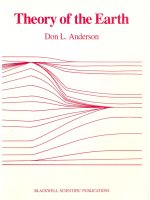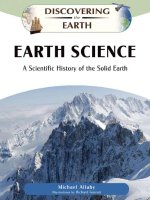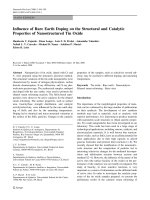- Trang chủ >>
- Khoa Học Tự Nhiên >>
- Vật lý
The restless earth layers of the earth
Bạn đang xem bản rút gọn của tài liệu. Xem và tải ngay bản đầy đủ của tài liệu tại đây (11.3 MB, 105 trang )
Th
s
s
e
Earth
l
t
s
e
eR
layers of
the earth
the restless earth
Earthquakes and Volcanoes
Fossils
Layers of the Earth
Mountains and Valleys
Rivers, Lakes, and Oceans
Rocks and Minerals
e
s
l
T
s
s
e
e
aRTh
R
e
h
T
layers of
the earth
Krista west
Layers of the Earth
Copyright © 2009 by Infobase Publishing
All rights reserved. No part of this book may be reproduced or utilized in
any form or by any means, electronic or mechanical, including photocopying,
recording, or by any information storage or retrieval systems, without permission
in writing from the publisher. For information, contact:
Chelsea House
An imprint of Infobase Publishing
132 West 31st Street
New York NY 10001
Library of Congress Cataloging-in-Publication Data
West, Krista.
Layers of the earth / Krista West.
p. cm. — (Restless earth)
Includes bibliographical references and index.
ISBN 978-0-7910-9706-9 (hardcover)
1. Earth—Juvenile literature. 2. Earth—Crust—Juvenile literature. 3. Earth—
Core—Juvenile literature. I. Title.
QE501.25.W47 2008
551.1—dc22
2008027075
Chelsea House books are available at special discounts when purchased in bulk
quantities for businesses, associations, institutions, or sales promotions. Please
call our Special Sales Department in New York at (212) 967-8800 or
(800) 322-8755.
You can find Chelsea House on the World Wide Web at
Text design by Erika K. Arroyo
Cover design by Ben Peterson
Printed in the United States of America
Bang EJB 10 9 8 7 6 5 4 3 2 1
This book is printed on acid-free paper.
All links and Web addresses were checked and verified to be correct at the time of
publication. Because of the dynamic nature of the Web, some addresses and links
may have changed since publication and may no longer be valid.
Contents
▲▲▲
1
2
3
4
5
6
7
The Dynamic Earth
7
The Crust
18
The Upper Mantle
29
The Lower Mantle
44
The Outer Core
59
The Inner Core
69
Studying the Earth
78
Glossary
88
Bibliography
93
Further Reading
97
Photo Credits
99
Index
100
About the Author
104
1
The Dynamic Earth
▲▲▲
ON A QUIET WINTER MORNING IN JANUARY 2006, A GIANT, SLEEPING
volcano on an unassuming, uninhabited island in Alaska awoke
from a 20-year nap. And it woke up with a bang.
At about 4:44 A.M., the volcano known as Mount St. Augustine
erupted, sending a cloud of steam and ash 45,000 feet (13,716
meters) into the air. Airplane pilots flying in the area quickly
reported the eruption, and the Federal Aviation Administration
temporarily restricted flights within 5 miles (8 kilometers) of
the rumbling mountain. At the same time, the United States
Geological Survey classified Augustine as an alert level red volcano, the highest level of concern. Everyone started to pay attention to Augustine.
The volcano continued to erupt for many days. Eventually,
it sent a steam cloud to the southeast, over a 45-mile-long (75kilometer-long) area. Amazingly, no one was hurt. To start with,
no one lived on Augustine’s remote island located in Alaska’s
Cook Inlet; the steam cloud never reached people living in the
large, nearby city of Anchorage; nor did it clog the engines of
unsuspecting airplanes passing by. Most people have never even
7
8
LAyErS of ThE EArTh
The subduction zone volcano Mount St. Augustine in Alaska woke
up from its 20-year nap in 2006.
heard of the Augustine volcano. Augustine’s eruption, however, is
a sign that the dynamic Earth is still active.
The St. Augustine volcano, named by explorer Captain James
Cook in 1778, is a classic subduction zone volcano. Subduction
zones are usually located on the ocean floor; they are areas where
one piece of Earth’s surface slides below another piece into the
interior of the planet. As the piece slides down, it absorbs the
ocean water. Once this water-logged piece of land sinks below
Earth’s surface, the water comes into contact with the surrounding rock, causing it to melt. As a result, the deep, surrounding
rock becomes much lighter than usual.
This pocket of light rock rises back towards Earth’s surface
like an ice cube floating up in a glass of water. On its journey to
the surface, it melts the surrounding rocks and forms a bubble of
The Dynamic Earth
Subduction occurs when a piece of Earth’s surface slides below
another piece into Earth’s interior. It is one of the many processes
that help shape the planet’s inner and outer layers.
liquid rock called magma. The magma supplies the lava that helps
create a new volcano. With repeated eruptions of lava, steam, and
ash at Earth’s surface, a new subduction volcano is born.
Subduction is just one of Earth’s many processes that have
helped shape the planet’s outer and inner layers over time. These
processes have likely slowed since the planet first formed, but
they have not stopped. Earth scientists work to understand how
the surface of the planet changes shape. Their job is not always
easy, and there is still much to learn.
STUDyIng EArTh’S LAyErS
All of Earth’s layers have an impact on human life in some way.
Some of the impacts are obvious, such as volcanic eruptions or
life-threatening earthquakes. Others are not so obvious, such
as the way in which the planet’s magnetic field protects the Earth
from the harmful energy in outer space. Obvious or not, human
9
10
LAyErS of ThE EArTh
Earth’s Layers
Depending where the lines are drawn, the Earth has five layers:
the crust, upper mantle, lower mantle, outer core, and inner core.
However, no one has ever actually seen the inner layers of the
planet. Everything we know about Earth’s interior has been deduced
by scientists gathering information at the Earth’s surface.
Thanks to this scientific research, humans now know the basic
ingredients and general size of each of Earth’s layers. Some of the
layers are solid like an ice cube, while others are semi-liquid like a
milkshake. Each layer is active and constantly changing.
Movements of rock and heat inside each layer give rise to different Earth processes. These processes help shape the planet as we
know it, as indicated in the following table:
Layers
Table 1.1: Earth’s
Layers
IngrEDIEnTS
of the Earth
APProX. %
of PLAnET
ThICKnESS
MoVEMEnT/
ProCESS
Crust
Basalt and
granite
0.5%
3-43 miles
(5-70 km)
Earthquakes
Upper
mantle
Peridotite
13%
217 miles
(350 km)
Plate
tectonics
Lower
mantle
Silica,
some iron
55%
1,553 miles
(2,500 km)
Convection
Outer
core
Liquid iron
30%
1,367 miles
(2,200 km)
Magnetic field
Inner
core
Solid iron
1.5%
746 miles
(1,200 km)
Heat
generation
The Dynamic Earth 11
life is directly affected by the processes that take place inside
the Earth.
The study of Earth’s layers ultimately helps humans to better
understand the planet’s processes, including those taking place
in its inner layers. Generally known as Earth science, this field
includes many different areas of scientific research. For example,
a geologist studying rocks on a mountain is one kind of earth
scientist; another type of earth scientist is the seismologist who
records the waves of energy that travel through the Earth following an earthquake.
Despite the many forms of Earth science, however, there are
really only two ways to study the Earth: with direct or indirect
observations. Because the Earth cannot be easily recreated in a
laboratory, scientists must look to the real world either directly
(with their own eyes) or indirectly (through the eyes of scientific
instruments).
Direct Science
Direct science uses real, concrete examples that can be observed,
measured, and studied with the human eye. Dissecting a frog to
learn about its biology is a form of direct science. So is measuring the speed of a ball as it falls through space. In Earth science,
geologists often use direct science to understand the history of
the planet.
Geologists have determined the age of Earth’s surface, for
example, by using radioisotopes. A radioisotope is the radioactive form of an element; that is, the atoms of that element slowly
lose particles—a process called decay—thereby turning into a different element entirely. Different types of radioactive elements
decay at predictable rates.
By directly measuring how much of a certain element has
decayed inside rocks on Earth’s surface, scientists can determine
the approximate age of that rock. Take two of the same rocks of
different ages. The rock with only half of the amount of the original element remaining is twice as old as the rock with all of the
12
LAyErS of ThE EArTh
element present. By measuring the decay of elements, scientists
can determine the age of Earth’s rocks.
This method of direct science is also called radioactive dating
or radiometric dating, and is an important tool in the field of
Earth science.
Indirect Science
Indirect science uses tools and instruments to look and listen
without observing something directly. One example of indirect
science is a doctor’s use of a stethoscope—an instrument—to listen to the heart. The heart is rarely ever seen directly.
Much of what scientists know about the inner layers of the
Earth comes from indirect science. seismology, for example, is
the study of waves of energy traveling through the Earth, a field
that plays a big role in the Earth sciences. Seismologists use tools
such as seismographs, which measure these waves, to learn about
different planet-shaping events. By studying the natural and
human-made waves of energy that travel through the layers of the
Earth, seismologists can learn much about the processes taking
place inside the planet.
whEn IT ALL BEgAn
About 5 billion years ago, our Sun condensed out of a cloud of
hydrogen gas and dust. Rotating around the newly formed star
was a disk of material that was rich in elements. Over a period of
about 500 million years, the material in the disk spread out and
began to clump together to form the planets. Planets that formed
from heavier elements clustered in closer to the Sun, while those
that formed from lighter elements traveled farther out into space.
During this time, the Earth formed as one of the four heavier,
inner planets.
At first, the Earth was no more than a giant ball of hot, melted,
mixed-up rock—unsorted and unorganized. This early Earth had no
breathable air, no life, no oceans, and none of the familiar landscapes seen today. But as time passed, the Earth changed.
The Dynamic Earth
Seismographs, the older cousin of modern seismometers, were used to
measure waves of energy traveling through the Earth.
On the outside of the planet, the atmosphere formed and
the oceans condensed. Inside the planet, the rocks began to cool
and settle out into more organized layers. Some of the melted
rocks began to solidify. Others naturally grouped together with
rocks of their own kind. The most dense and heavy of these
rocks sank to the center of the planet while the less dense,
lighter, molten rock floated to the surface. Over hundreds of
millions of years, the planet began to harden and take shape,
while settling into three main layers: the core, the mantle, and
the crust.
Earth’s layers can be imagined as a hard-boiled egg. The
familiar layers in a hard-boiled egg are the shell, the squishy
white part, and the hard yellow yolk. The shell is thin, brittle,
13
14
LAyErS of ThE EArTh
and cracks easily; the white part is thick, soft, and squishy; and
the yolk is a solid and tightly packed ball. Earth’s layers are not
all that different.
Is Earth Alone?
Evidence for the existence of other Earth-type planets in outer space
may not come in the form of little green alien visitors but instead
be found in the rocks known as meteorites that fall to the planet’s
surface. Meteorites are evidence of other rocky planets that may not
have survived as the Earth did.
Most meteorites come in three forms: stony, iron-based, and
stony-iron mixtures. Stony meteorites often resemble the rocks found
on Earth. Iron-based meteorites are made mostly of slowly-cooled
iron, as might be found in the core of a planet or large asteroid. The
third type of meteorite, known as a “stony iron,” has both Earthlike rocks and slow-cooled iron. These rare meteorites seem to have
come from the boundary between a planet’s iron core and its rocky
outer layer.
The ingredients that make up these meteorites provide important
clues that point toward the existence of planets with Earthlike layers, because these ingredients could not have formed in space on
their own. The only way such meteorites could have been created,
scientists suggest, is on an Earthlike planet. Evidence suggests that
a small, rocky planet may have formed elsewhere and then broken up,
dispersing pieces of Earthlike rock through space. When these rocks
fall to Earth, they become meteorites.
Earth, it seems, was not the only rocky, layered planet to be created in our solar system. But it may be the only survivor.
The Dynamic Earth 15
Core
If the Earth is like a giant, hard-boiled egg, then the core of the
Earth is like the yolk. As the planet cooled, the heavy iron contained in the mix of melted rock started to separate out to collect
as a core at the center of the planet.
According to some earth scientists, core formation happened
very early in the history of the Earth, perhaps within the first hundred million years after the planet formed. During this period, a
solid, inner core and a semi-liquid outer core took shape. Most
scientists believe this inner core is still heated by warmth left over
from the collision and accretion of the many asteroids and meteors (called planetesimals) that originally formed the planet.
Scientists now estimate that the Earth’s solid-iron, inner core
is about 746 miles (1,200 km) across, about the same size as the
moon. The liquid-iron, outer core is about 1,367 miles (2,200
km) across. The inner and outer cores together make up about
30% of the Earth by volume.
Mantle
Comparing the Earth with a giant, hard-boiled egg means the
mantle is like the egg’s thick, squishy white part. As the planet
cooled and the heavy iron fell to the center, the lighter silicate
rocks floated in the mantle above. Silicates include all kinds of
rocks, usually containing the elements silicon and oxygen. Earth’s
mantle is believed to be made up of mostly silicate rocks.
Rocks in the mantle look more like those typically found at
the Earth’s surface. However, these rocks are kept warm by both
the decay of radioactive elements and by the heat from the core.
Because they are also subjected to pressure from the crust above,
they tend to be semi-liquid, or viscous. The mantle, like the core,
is thought to have formed very early in the history of the Earth.
Scientists now estimate that the thick-flowing mantle is
about 1,800 miles (2,900 km) thick—taking up about 70% of the
Earth by volume. Many earth scientists divide the mantle into the
16
Layers of the earth
upper and lower mantle based on the properties and behaviors of
the different rocks.
Crust
If the Earth is a giant, hardboiled egg, then the crust of the Earth
is like the thin, brittle eggshell. Unlike the core and the mantle,
the Earth’s crust did not form from heavy and light elements that
separated themselves early in Earth’s history. Instead, the crust is
constantly formed, destroyed, and reformed by processes happen
ing inside the mantle.
The rocks in Earth’s crust are primarily basalts and granites.
Basalts are gray or black, finetextured, heavy rocks. Granites
are notsoheavy pink, gray, or black rocks. The crust contains
many other elements including sodium, aluminum, potassium,
and iron.
Today, scientists estimate that Earth’s crust is only 22 miles
(35 km) deep on average. At its thickest points, the crust is no
more than 50 miles (70 km) deep.
If comparing the Earth to an egg, the core would be the yolk
(above). The Earth is made up of layers of varying thickness
(opposite).
The Dynamic Earth 17
By first understanding how the Earth formed, then studying
the processes that constantly shape the layers of the Earth, scientists are discovering more and more about the planet. And there is
still much to discover. No one, for example, knows exactly when
a volcano will erupt; how violently an earthquake will shake; or
why the planet’s magnetic poles move around. For Earth scientists, many mysteries remain to be solved.
2
The Crust
▲▲▲
THE CRUST OF PLANET EARTH IS, AS DESCRIBED IN CHAPTER 1, LIKE THE
shell of a hard-boiled egg: very thin and very hard compared to the
inner layers. And, like an egg’s shell, the crust is quite crackable.
When Earth’s crust cracks, an earthquake happens. Over
time, these earthquakes have helped to shape the planet’s crust.
They help build mountains, create oceans, and sculpt all the land
in between. Earthquakes happen all the time, all over the Earth,
and can be both visible and invisible to humans. But earthquakes
are not random events. They happen for a reason.
Earthquakes are the end result of complicated forces and
processes taking place inside the crust. On the surface, the crust
may look fairly stable and still most of the time. A mountain, for
example, does not usually move a lot. But inside the crust, big
sections of rock are constantly moving and shifting. In fact, the
whole crust is constantly changing and moving.
CrUST BASICS
To understand how earthquake processes shape the crust, it helps
to first understand a bit more about what makes up the crust.
18
The Crust 19
Thickness
The Earth’s crust is a relatively thin layer of rock that is part of
Earth’s lithosphere. Its thickness varies a little depending on
its location on the planet’s surface. The crust under the oceans
is thin, measuring between 3 and 6 miles (5 and 10 km) thick.
The crust under the land, particularly under mountains, is much
thicker, measuring between 12 and 50 miles (20 and 70 km)
thick.
At its thickest point, a car moving at highway speed toward
the center of the Earth would arrive at the bottom of the crust in
about an hour. That’s a quick drive.
Driving at the same speed through all of Earth’s layers to the
center of the planet would take more than 76 hours. That onehour drive through the crust indicates that the crust is very thin
compared to the area covered in the 76-hour drive to the planet’s
center.
Ingredients
Earth has two types of crust: oceanic crust and continental crust.
Oceanic crust, the layer found beneath the oceans, is made up
of rocks called basalts. These gray or black, fine-textured, dense,
heavy rocks are squeezed out of underwater volcanoes. Though
these volcanoes are not easily seen, the ocean floors are full of
them.
Continental crust is the layer of crust that makes up dry
land and is made largely of rocks called granite. Granites are pink,
gray, or black rocks that have melted and solidified on Earth’s
surface over time. Compared to basalts, granites are very light and
loosely packed.
Age
Oceanic crust is much younger than continental crust because
oceanic crust is constantly being made and destroyed as underwater volcanoes erupt to make new oceanic basalts and add new
20
LAyErS of ThE EArTh
rocks to the oceanic crust. During this process, certain areas in
the ocean floor, called subduction zones, pull the older, heavy
oceanic crust back into the interior of the Earth, destroying it.
The rate at which this ongoing process of creating and destroying oceanic crust occurs means that none of these rocks are very
old—none of the oceanic basalts are more than 100 million years
old. While this may sound like forever in terms of human history, most of the oceanic crust was formed during the last 2% of
Weathering Reshapes
New Hampshire
In May 2003, the state symbol of New Hampshire—a 40-foot-high
(12 m) natural rock that resembled a human profile—toppled off the
side of the mountain where it had stood for millions of years. The
“Old Man of the Mountain” that graced the state’s license plates,
quarters, and souvenirs was no more.
The natural destruction of the “Old Man of the Mountain” is one
example of the processes that shape the crust of the Earth. However,
this event was not caused by a dramatic, jolting earthquake but by
the slow, steady process of rock weathering.
weathering is the breaking down of rocks on Earth’s surface
by wind, water, heat, and pressure. By this process, a large chunk
of rock, like the rock face that turned into the “Old Man of the
Mountain,” is broken into smaller and smaller pieces of rock and
helps shape the crust. In some cases, weathering results in soft,
rounded river stones. In other cases, weathering results in dramatic
changes in the shape of mountains.
New Hampshire’s “Old Man of the Mountain” was formed naturally from five layers of granite rock. The structure toppled after the
weathering process slowly wore down the bottom layers of granite
The Crust
Earth’s history. That means if the Earth were only 5 years old, the
basalts would be only a few hours old.
The continental crust is much older than the oceanic crust.
While it is constantly being created, it is rarely destroyed. Melted
rocks from beneath the crust rise to the surface (either through
volcanoes or other openings in Earth’s crust) and solidify into
granites, adding new rocks to the continental crust. But because
these rocks are so light, they rarely sink deep enough into the
that supported the rock structure. For a long time, people were aware
that weathering was weakening the Old Man, but no one was able to
stop this natural process from taking its course.
Today, many visitors to the site leave flowers as a token of
remembrance for the “Old Man of the Mountain.”
(a)
(b)
The natural process of rock weathering slowly weakened New
Hampshire’s “Old Man of the Mountain.” The picture on the left
(a) shows the mountain before the rock face fell; the picture on the
right (b) shows how it looked afterward.
21
22
LAyErS of ThE EArTh
oceans to reach the subduction zones where they would be
destroyed.
As a result, continental crust rocks are a lot older. They can
be as much as 3.8 billion years old (that’s 38 times older than
oceanic crust rocks). Again, if the Earth were only 5 years old, the
granites would be only a couple of weeks old. That’s a lot older
than the oceanic crust, but still young when compared to the
entire history of the planet.
forCES In ThE CrUST
All the rocks in Earth’s crust—both oceanic and continental—are
under constant stress, a force that causes the crust to change
its shape, size, and location. The exact amount and type of stress
varies. Stress at the surface of the Earth comes from the layers
below the crust, deep in the upper mantle. Stress takes three basic
forms: stretching, smashing, and shearing
Stretching
tension is the force that stretches the crust apart, making it
thinner in the middle. Over time, this action can create giant
valleys and basins. The Great Basin, located between Utah and
California, is one example of a low spot on Earth’s surface that
was created by tension forces.
Smashing
Compression is the force that pushes the crust together,
squeezing it until it folds or breaks. This folding action formed
Earth’s mountain ranges. The central Appalachian Mountains in
Pennsylvania, for example, were created by compression forces
that folded Earth’s crust.
Shearing
shearing is the force that pushes a piece of rock in two opposite
directions, causing a break or change of shape. Sheared areas of
Earth’s crust can form large areas of raised, flat land that are
the Crust
called plateaus. One example is the Colorado Plateau, a raised
area of land that covers the corners of Arizona, Utah, Colorado,
and New Mexico.
All rocks in the Earth’s crust undergo stress, which causes the crust
to change in different ways.
23
24
LAyErS of ThE EArTh
EArThQUAKES In ThE CrUST
With enough stretching, smashing, or shearing, the rocks in
Earth’s crust will simply break apart. Some solid rocks can stretch
and stretch like a piece of taffy, but all rocks will eventually break.
Once broken, the rocks in the crust are free to move much faster
and cause earthquakes.
Scientists call a break in Earth’s crust a fault. There are three
basic forms of faults: normal faults, thrust faults, and strike/slip
faults.
normal fault
A normal fault happens when tension forces stretch the crust
apart. When the fault stretches to its breaking point, the rocks
suddenly move along the direction of the force and cause an
earthquake. A normal fault breaks the crust at an angle so that
one piece of rock slides up and one piece of rock slides down.
The rocks that slide up can become mountains or plateaus; the
rocks that slide down can become rifts or river valleys.
The Rio Grande Rift, stretching from Mexico through Texas
and New Mexico, and into Colorado, is an example of a normal
fault at a rift valley. The Rio Grande Rift is a low-lying river valley that is undergoing tension forces that are slowly pulling the
rocks apart. The valley results from the downward-moving side of
a large normal fault that is shaping the crust.
A fault-block mountain is a type of mountain created
when two normal faults line up next to each other. This creates two breaks in the crust parallel to each other, forming a
loose block of rock between the breaks. The loose block moves
upward to form a mountain, while the surrounding rocks move
downward.
One example of a fault-block mountain range is the Franklin
Mountains, which run from north to south, splitting the west
Texas city of El Paso down the middle. The fault-block range itself
is thrust upward relative to the adjacent rock units immediately
east and west of the range.









